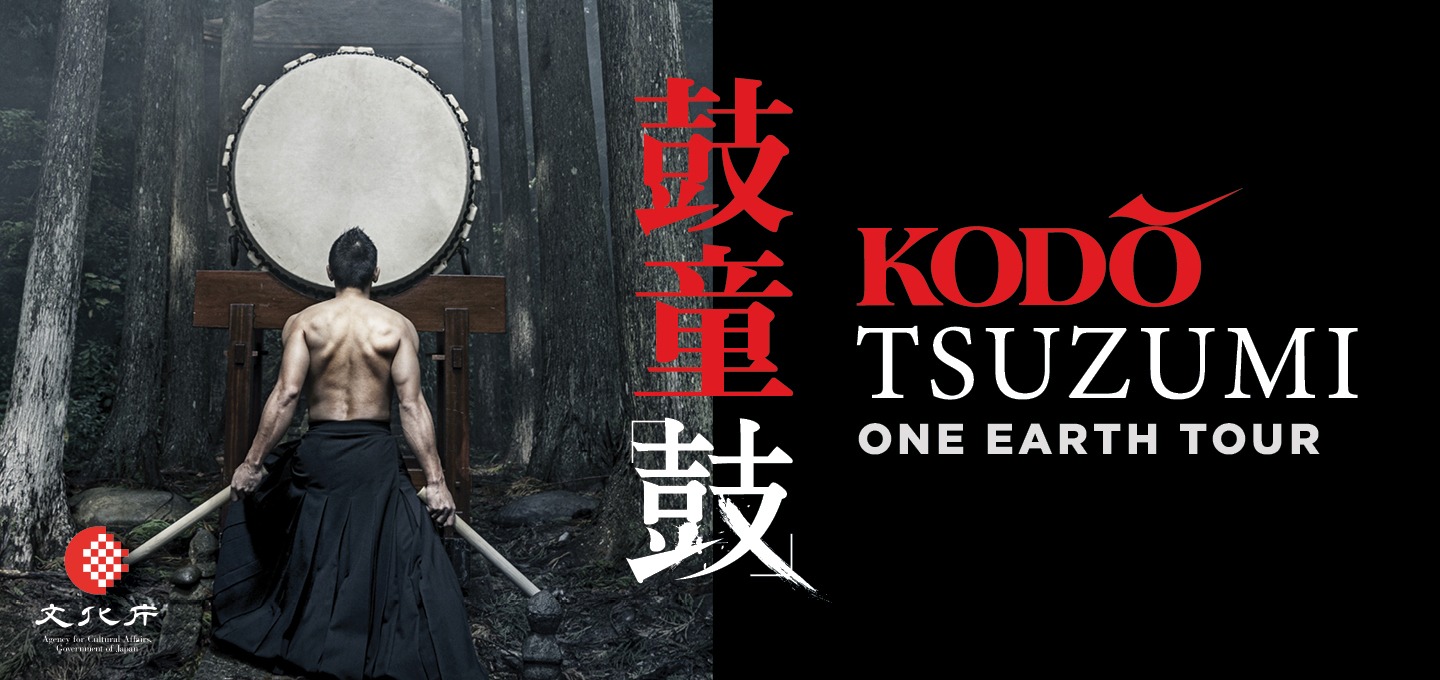Drumming from the Heart of Our Planet:
Kodō Drummers’ “One Earth Tour” at Schermerhorn Symphony Center
Kodō has a double meaning. In Japanese, it means both “heartbeat” and “children of the drum.” This latter also has a double meaning. It means children listening to the heartbeat in their mothers’ wombs and it means playing music with the open heart of a child. 
From small shime-daiko, its two drum heads tightened with heavy rope, through the medium sized nagado-daiko, the size of a barrel with its heads nailed on, to the massive ō-daiko towering over the players, often decorated with the tomoe, a design resembling three swirling commas representing the earth’s motion, all these drums [taiko or daiko] and more have rested at the heart of the Kodō drummers existence. Since the troupe’s founding in 1971 by an idealistic assemblage of aspiring musicians, the drummers have brought this folk tradition to the world.
Jacques Holender’s 1984 documentary revealed the mystical experience of taiko drumming. In Kodō: Heartbeat Drummers of Japan the players “live, learn, create” together by eating together, sleeping on tatami mats, singing together, running together, all to develop the mental strength and physical stamina to play some of the largest drums on earth with bachi, thick cylindrical drum sticks.
Those who like martial arts movies would recognize the life of a Kodō drummer. Like a Buddhist sect, the drummers live and train year round on Sado Island in the Sea of Japan. This island is an arts mecca where the drummers have their own village with dormitories and buildings for rehearsing, recording, and building instruments.
The current travelling group of nearly forty members includes nine women. In fact, women were among the founding members. This is worth noticing because in many cultures, drumming is limited to men.
Sixty to one hundred members form the Kodō village community. They do their own cooking and cleaning, as well as working with local artisans to make the drums and other instruments like the shinobue [slim transverse bamboo flute] and chappa [small cymbals approximately six inches in diameter].
The program opened with the hyoshigi, wooden clappers used to wake the drummers each morning. Dressed in their uniform of white tabi socks, black pants, topped with a loose black top with white designs in Japanese script, and a white sweatband. The performers enter the stage with calm focus and take their opening kata, a word for “position” that is also used in martial arts.
Throughout the program they control dynamics, moving from barely audible fingertips on a small drumhead to earth-shattering pounding on a stageful of drums. The uchiwa daiko, paddle drums shaped like small tennis rackets of varying sizes, added a nice change of pitch and timbre from the booming of the larger drums.
To play the largest of the drums, the ō-daiko, two players dressed only in the sweatband and loincloths showed the full-body strength required to create full resonance on the massive drum. It’s common to thing of the arms and back as sources of strength for drumming, but the glutes and hamstrings, all the way down to the feet were all engaged in drawing sound from these drums. And even the arms move beyond the typical, requiring both the forehand and backhand control of a pro tennis player.

The smaller chu-daiko require the drummers to sit on the floor, anchoring the drum with their feet, while angling the upper body back for maximum strike power. This exemplifies the need for the ab crunches that form part of their stringent exercise regime.
Three drummers leavened this impressive exhibition of strength, training, and art with a bit of rollicking humor reminiscent of a Cirque de Soleil skit: imitating one another, marching like a band, doing squatting kicks like Russian cossacks of olde, freezing in place. Yet even movements intended for humor demonstrate the remarkable physical control the musician-athletes possess and use with ease.
One of the most exciting that showed they’re not afraid to unleash their power more overtly was the dynamic performance of a solo drummer placed center stage and surrounded by five drums of differing sizes. The performance was fast and furious, sometimes turning the soloist into a blur of motion. All was not fortissimo, fury, and fun, though. One particular moment spotlighted the versality of the performers with a lovely folk melody featuring both singing and flutes. It embodied the spirit of a plaintive ballad. Flutes later returned playing chord clusters much like the dissonant mouth organ known as the shō, and in the Japanese version of a fife and drum corps, with cymbals added.
The sections of this performance were much more varied than when I last saw the ensemble around fifteen years ago, but there is a noticeable decline in the tightness of the rhythms as well. That could be the result of featuring what appear to be much younger players, perhaps with less training. Overall, however, the program was entertaining and impressive.
It ended with a creative curtain call allowing recognition for each section, the singers, flutists, and soloists on the medium and massive drums. The audience, massive itself, gave these Kodō drummers their well-deserved kudos.
- About the Author
- Latest Posts
Y Kendall is a Stanford-educated musicologist, specializing in dance history who recently earned an MFA in Creative Nonfiction at Columbia University, studying nonfiction writing with Ben Ratliff and Margo Jefferson. Kendall’s diverse works have been published in Alchemy: Journal of Translation, Columbia Journal, Mitos Magazín, The Hunger Mountain Review, and The Salt Collective, among others. Born and raised in Tennessee, Kendall now lives near Nashville, freelancing as a flutist and writer, while caregiving for relatives.



